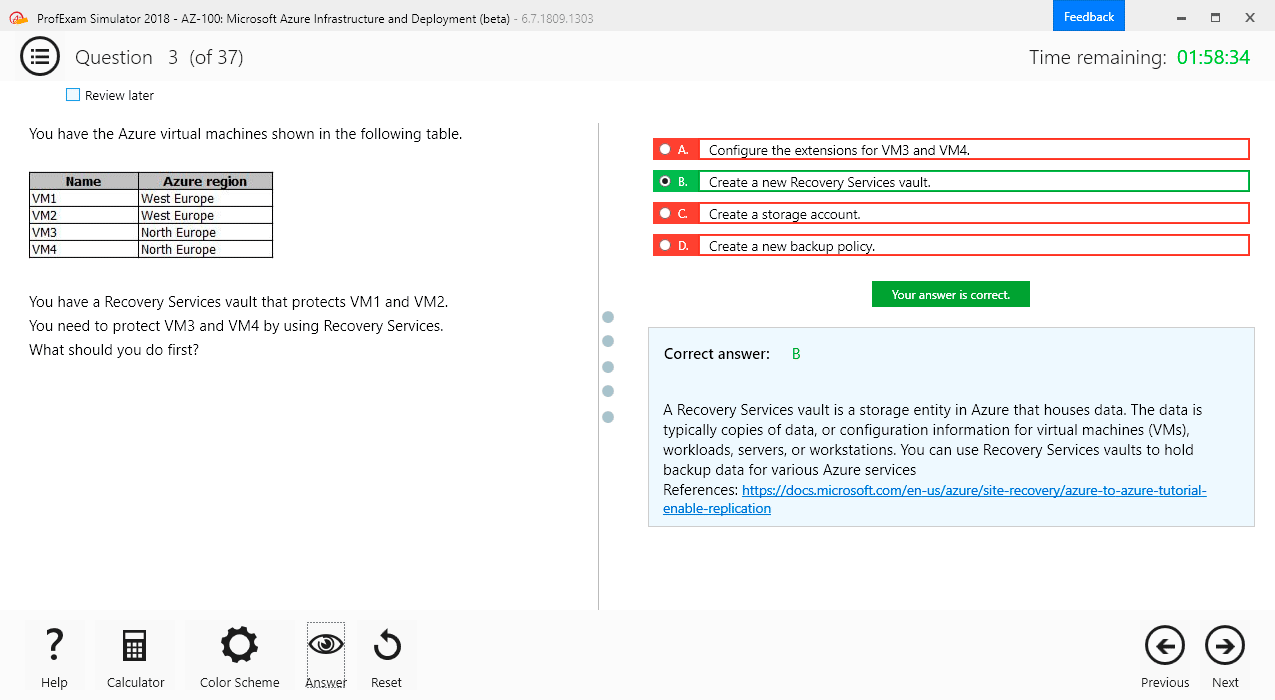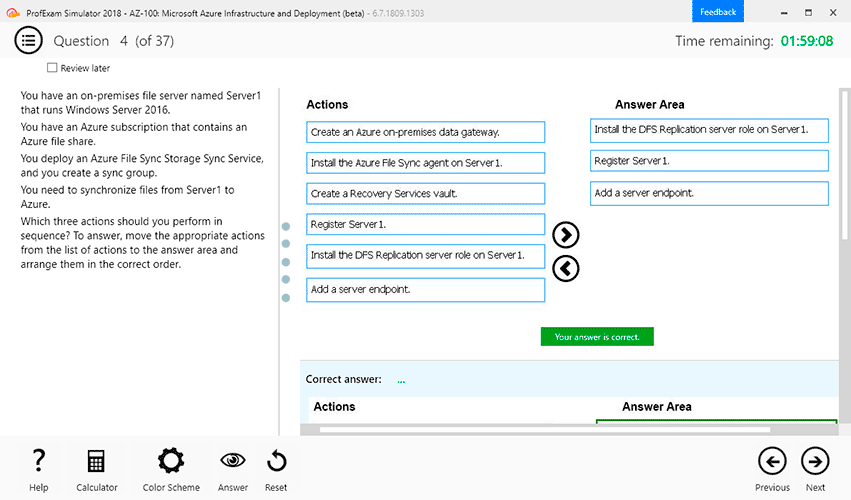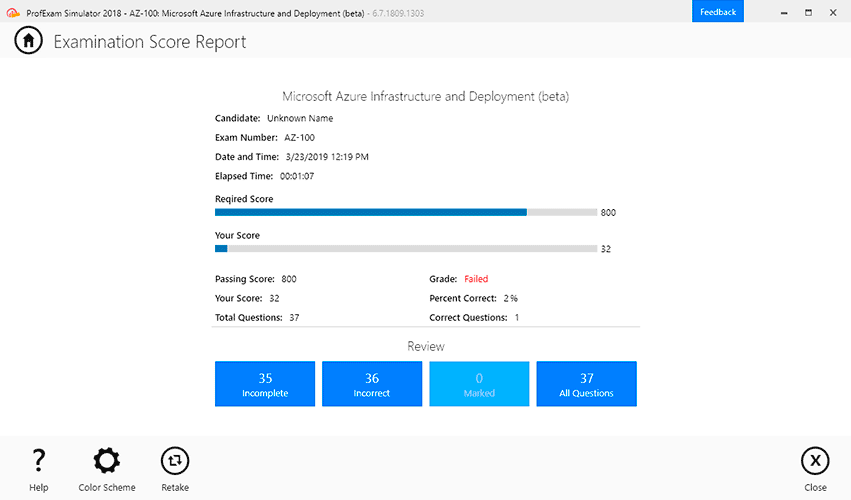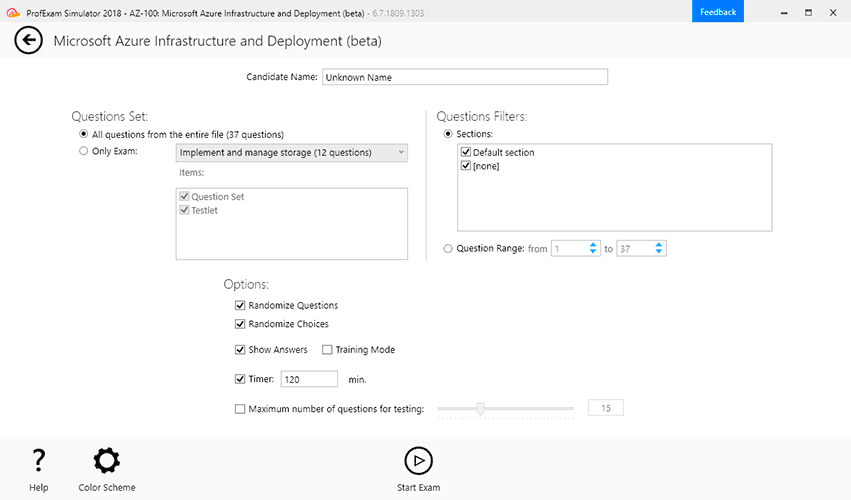File Info
| Exam | Professional Cloud Network Engineer |
| Number | Professional-Cloud-Network-Engineer |
| File Name | Google.Professional-Cloud-Network-Engineer.VCEplus.2024-08-19.90q.tqb |
| Size | 666 KB |
| Posted | Aug 19, 2024 |
| Download | Google.Professional-Cloud-Network-Engineer.VCEplus.2024-08-19.90q.tqb |
How to open VCEX & EXAM Files?
Files with VCEX & EXAM extensions can be opened by ProfExam Simulator.
Coupon: MASTEREXAM
With discount: 20%






Demo Questions
Question 1
You are designing a Google Kubernetes Engine (GKE) cluster for your organization. The current cluster size is expected to host 10 nodes, with 20 Pods per node and 150 services. Because of the migration of new services over the next 2 years, there is a planned growth for 100 nodes, 200 Pods per node, and 1500 services. You want to use VPC-native clusters with alias IP ranges, while minimizing address consumption.
How should you design this topology?
- Create a subnet of size/25 with 2 secondary ranges of: /17 for Pods and /21 for Services. Create a VPC-native cluster and specify those ranges.
- Create a subnet of size/28 with 2 secondary ranges of: /24 for Pods and /24 for Services. Create a VPC-native cluster and specify those ranges. When the services are ready to be deployed, resize the subnets.
- Use gcloud container clusters create [CLUSTER NAME]--enable-ip-alias to create a VPC-native cluster.
- Use gcloud container clusters create [CLUSTER NAME] to create a VPC-native cluster.
Correct answer: A
Explanation:
The service range setting is permanent and cannot be changed. Please seehttps://stackoverflow.com/questions/60957040/how-to-increase-the-service-address-range-of-agke-clusterI think the correc tanswer is A since: Grow is expected to up to 100 nodes (that would be/25), then up to 200 pods per node (100 times 200 = 20000 so /17 is 32768), then 1500 services in a/21 (up to 2048)https://docs.netgate.com/pfsense/en/latest/book/network/understanding-cidr-subnet-masknotation.html The service range setting is permanent and cannot be changed. Please see
https://stackoverflow.com/questions/60957040/how-to-increase-the-service-address-range-of-agke-cluster
I think the correc tanswer is A since: Grow is expected to up to 100 nodes (that would be/25), then up to 200 pods per node (100 times 200 = 20000 so /17 is 32768), then 1500 services in a/21 (up to 2048)
https://docs.netgate.com/pfsense/en/latest/book/network/understanding-cidr-subnet-masknotation.html
Question 2
Your company's web server administrator is migrating on-premises backend servers for an application to GCP. Libraries and configurations differ significantly across these backend servers. The migration to GCP will be lift-andshift, and all requests to the servers will be served by a single network load balancer frontend. You want to use a GCP-native solution when possible.
How should you deploy this service in GCP?
- Create a managed instance group from one of the images of the on-premises servers, and link this instance group to a target pool behind your load balancer.
- Create a target pool, add all backend instances to this target pool, and deploy the target pool behind your load balancer.
- Deploy a third-party virtual appliance as frontend to these servers that will accommodate the significant differences between these backend servers.
- Use GCP's ECMP capability to load-balance traffic to the backend servers by installing multiple equal-priority static routes to the backend servers.
Correct answer: B
Question 3
You decide to set up Cloud NAT. After completing the configuration, you find that one of your instances is not using the Cloud NAT for outbound NAT.
What is the most likely cause of this problem?
- The instance has been configured with multiple interfaces.
- An external IP address has been configured on the instance.
- You have created static routes that use RFC1918 ranges.
- The instance is accessible by a load balancer external IP address.
Correct answer: B
Question 4
You want to set up two Cloud Routers so that one has an active Border Gateway Protocol (BGP) session, and the other one acts as a standby.
Which BGP attribute should you use on your on-premises router?
- AS-Path
- Community
- Local Preference
- Multi-exit Discriminator
Correct answer: D
Question 5
You are increasing your usage of Cloud VPN between on-premises and GCP, and you want to support more traffic than a single tunnel can handle. You want to increase the available bandwidth using Cloud VPN.
What should you do?
- Double the MTU on your on-premises VPN gateway from 1460 bytes to 2920 bytes.
- Create two VPN tunnels on the same Cloud VPN gateway that point to the same destination VPN gateway IP address.
- Add a second on-premises VPN gateway with a different public IP address. Create a second tunnel on the existing Cloud VPN gateway that forwards the same IP range, but points at the new onpremises gateway IP.
- Add a second Cloud VPN gateway in a different region than the existing VPN gateway. Create a new tunnel on the second Cloud VPN gateway that forwards the same IP range, but points to the existing on-premises VPNgateway IP address.
Correct answer: C
Explanation:
https://cloud.google.com/network-connectivity/docs/vpn/concepts/classic-topologies#redundancyoptions https://cloud.google.com/network-connectivity/docs/vpn/concepts/classic-topologies#redundancyoptions
Question 6
You want to establish a dedicated connection to Google that can access Cloud SQL via a public IP address and that does not require a third-party service provider.
Which connection type should you choose?
- Carrier Peering
- Direct Peering
- Dedicated Interconnect
- Partner Interconnect
Correct answer: B
Explanation:
When established, Direct Peering provides a direct path from your on-premises network to Google services, including Google Cloud products that can be exposed through one or more public IP addresses. Traffic from Google's network to your on-premises network also takes that direct path, including traffic from VPC networks in your projects. Google Cloud customers must request that direct egress pricing be enabled for each of their projects after they have established Direct Peering with Google. For more information, see Pricing.Reference: https://cloud.google.com/interconnect/docs/how-to/direct-peering When established, Direct Peering provides a direct path from your on-premises network to Google services, including Google Cloud products that can be exposed through one or more public IP addresses. Traffic from Google's network to your on-premises network also takes that direct path, including traffic from VPC networks in your projects. Google Cloud customers must request that direct egress pricing be enabled for each of their projects after they have established Direct Peering with Google. For more information, see Pricing.
Reference: https://cloud.google.com/interconnect/docs/how-to/direct-peering
Question 7
You are configuring a new instance of Cloud Router in your Organization's Google Cloud environment to allow connection across a new Dedicated Interconnect to your data center Sales, Marketing, and IT each have a service project attached to the Organization's host project.
Where should you create the Cloud Router instance?
- VPC network in all projects
- VPC network in the IT Project
- VPC network in the Host Project
- VPC network in the Sales, Marketing, and IT Projects
Correct answer: C
Explanation:
Reference: https://cloud.google.com/interconnect/docs/how-to/dedicated/using-interconnectsother-projects Reference: https://cloud.google.com/interconnect/docs/how-to/dedicated/using-interconnectsother-projects
Question 8
You created a new VPC for your development team. You want to allow access to the resources in this VPC via SSH only.
How should you configure your firewall rules?
- Create two firewall rules: one to block all traffic with priority 0, and another to allow port 22 with priority 1000.
- Create two firewall rules: one to block all traffic with priority 65536, and another to allow port 3389 with priority 1000.
- Create a single firewall rule to allow port 22 with priority 1000.
- Create a single firewall rule to allow port 3389 with priority 1000.
Correct answer: C
Explanation:
Reference: https://geekflare.com/gcp-firewall-configuration/ Reference: https://geekflare.com/gcp-firewall-configuration/
Question 9
You are disabling DNSSEC for one of your Cloud DNS-managed zones. You removed the DS records from your zone file, waited for them to expire from the cache, and disabled DNSSEC for the zone. You receive reports that DNSSEC validating resolves are unable to resolve names in your zone.
What should you do?
- Update the TTL for the zone.
- Set the zone to the TRANSFER state.
- Disable DNSSEC at your domain registar.
- Transfer ownership of the domain to a new registar.
Correct answer: C
Explanation:
Before disabling DNSSEC for a managed zone you want to use, you must deactivate DNSSEC at your domain registrar to ensure that DNSSEC-validating resolvers can still resolve names in the zone. Before disabling DNSSEC for a managed zone you want to use, you must deactivate DNSSEC at your domain registrar to ensure that DNSSEC-validating resolvers can still resolve names in the zone.
Question 10
You have an application hosted on a Compute Engine virtual machine instance that cannot communicate with a resource outside of its subnet. When you review the flow and firewall logs, you do not see any denied traffic listed.
During troubleshooting you find:
- Flow logs are enabled for the VPC subnet, and all firewall rules are set to log.
- The subnetwork logs are not excluded from Stackdriver.
- The instance that is hosting the application can communicate outside the subnet.
- Other instances within the subnet can communicate outside the subnet.
- The external resource initiates communication.
What is the most likely cause of the missing log lines?
- The traffic is matching the expected ingress rule.
- The traffic is matching the expected egress rule.
- The traffic is not matching the expected ingress rule.
- The traffic is not matching the expected egress rule.
Correct answer: C

